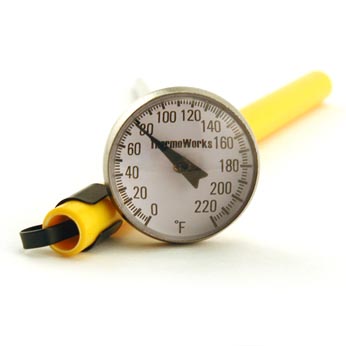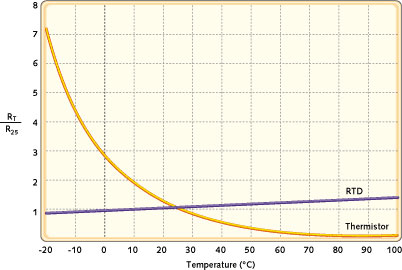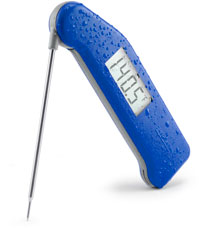How To Repair Spring Loaded Thermometer
Basic Thermometry Concepts: Thermometer Technologies
 As nosotros accept discussed previously, there are thermometers that measure many unlike types of concrete characteristics, just the five most common include: liquid expansion devices, bi-metallic devices, resistance temperature devices (RTD'southward and thermistors), thermocouples and infrared radiation devices.
As nosotros accept discussed previously, there are thermometers that measure many unlike types of concrete characteristics, just the five most common include: liquid expansion devices, bi-metallic devices, resistance temperature devices (RTD'southward and thermistors), thermocouples and infrared radiation devices.
Bi-metals have dial displays. The dial is connected to a spring coil at the heart of the probe. The spring coil is made of two different types of metallic that expand in dissimilar (yet predictable) means when exposed to rut. The expansion of the coil with estrus pushes the needle on the punch. Bi-metal thermometers are very cheap, and typically take several minutes to come to temperature. Not to mention, their unabridged metal coil has to exist immersed in the material beingness measured to get an accurate reading (normally more than an inch or two).
Liquid thermometers and bi-metals are mechanical thermometers that don't need any electricity to function. Bi-metal thermometers also get out of calibration very easily and need to be re-calibrated weekly or even daily using an ice bath. Adjustments tin can be made using a elementary screw that rewinds the metal curl.
 Electronic thermometers (RTD'south, thermistors and thermocouples) measure the affects of heat on electronic currents. Resistance devices (RTD'southward and thermistors) take reward of the fact that electric resistance reacts to changes in temperature forth predictable curves.
Electronic thermometers (RTD'south, thermistors and thermocouples) measure the affects of heat on electronic currents. Resistance devices (RTD'southward and thermistors) take reward of the fact that electric resistance reacts to changes in temperature forth predictable curves.
Both the thermistor and its loftier-precision "standards thermometer" cousin - the RTD - measure resistance in a resistor attached to an electronic circuit to summate temperature. Thermistors typically apply ceramic beads equally resistors, while RTD'south often apply either platinum (a highly stable metal) or other metal films.
With thermistors, resistance decreases with temperature and with RTD'southward, resistance increases. Both thermistors and RTD'south may have a higher degree of accuracy than thermocouples, simply their range is limited by comparing and they are by and large not every bit fast.
 Thermocouples work on the principle, that when connected to ii dissimilar metals across a span with a temperature difference, an electronic excursion is generated. The voltage of the generated circuit changes with variations in temperature in predictable means. Common thermocouples weld together nickel and chromium (chosen Type Chiliad), copper and constantan (Type T) or iron and constantan (Type J) and identify the weld at the very tip of the thermometer probe.
Thermocouples work on the principle, that when connected to ii dissimilar metals across a span with a temperature difference, an electronic excursion is generated. The voltage of the generated circuit changes with variations in temperature in predictable means. Common thermocouples weld together nickel and chromium (chosen Type Chiliad), copper and constantan (Type T) or iron and constantan (Type J) and identify the weld at the very tip of the thermometer probe.
Since thermocouples only generate voltage when in that location is a difference in temperature along the circuit (and the departure in temperatures needs to be known to calculate a temperature reading), thermocouples either have a "cold junction" where part of the circuit is brought to the ice point (32°F/0°C) or an electronic "cold junction" compensation that aids in the calculation. Thermocouples can discover temperatures across wide ranges and are typically very fast.
Source: https://www.thermoworks.com/thermometry101_basic_concepts_thermometer_technologies
Posted by: matoseupis1955.blogspot.com


0 Response to "How To Repair Spring Loaded Thermometer"
Post a Comment